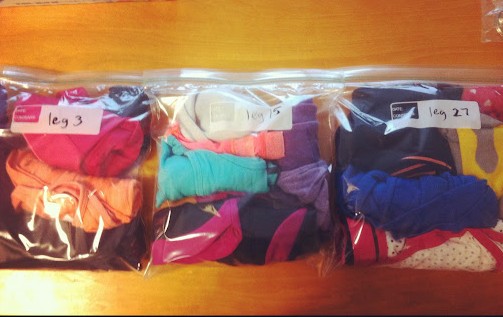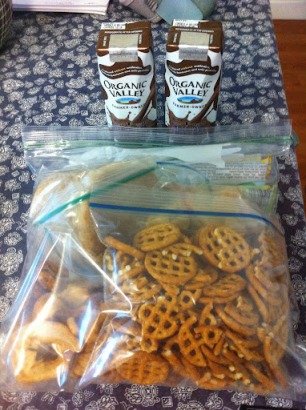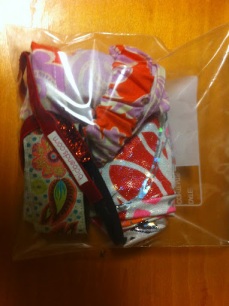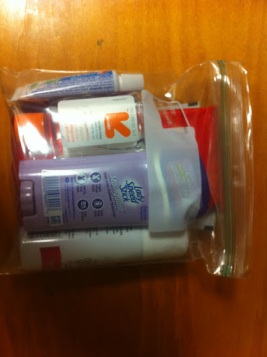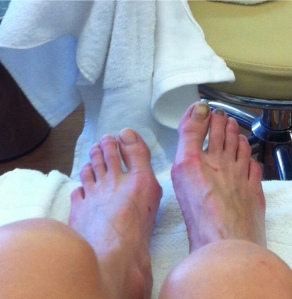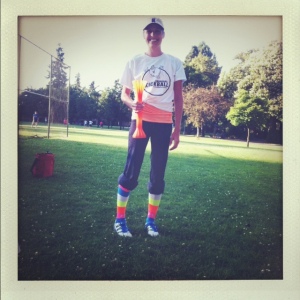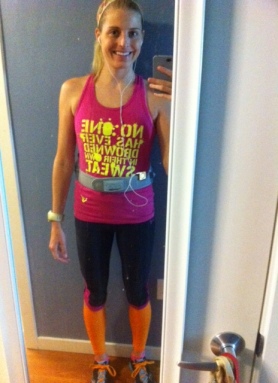I haven’t been keeping up with my blogging very well, so I’m going to split my Ragnar recaps into a few posts and get more, er, mileage out of the topic. (Mileage! Har har.)
So let’s say you’ve joined a 12-person team with the goal to run 200 miles in under 30 hours. First, you’re a lunatic. :) Second, how should you pack?
In two words: lightly and strategically.
I cannot stress this enough: Gallon-size Ziploc baggies are your friend.
If you take my advice, this will happen: While everyone else is tearing their bags apart, looking for that pair of dry socks or that chocolate-raspberry-flavored granola bar, you’ll be sitting fat and happy in the back of the van with socks, bar, music and travel pillow in hand.
I’ll make this super easy on ya …
WHAT TO PACK
running-related
- 3 running shorts (or tights or capris, depending on the weather)
- 3 running tops (add a long sleeve running top or two, if you need to layer)
- 3 sports bras, 3 pairs of underwear, 3 pairs of socks (sub in compression socks, if you like)
- running shoes
- running belt (if you want to carry water or gels)
- headbands & hair ties
- iPad & headphones
- visor or hat (if it’s super sunny)
- headlamp
- Garmin
other clothes
- sweatpants or yoga pants to wear in between runs
- sweatshirt
- rain jacket (if you’re in the Pacific Northwest … even if it’s July … grrr)
- extra underwear, bra, semi normal outfit for when you’re all done
- sunglasses
food-related
On the night before the race (Thursday), we ate dinner near our motel. The motel had continental breakfast, so we were covered for Friday morning. We planned to stop at a restaurant for a late lunch/early dinner during our break on Friday (after every runner in our van did their first runs, and we handed off to van #2 for their first set of runs). So Friday was mostly covered, except for snacks. Then, we needed food for Saturday’s breakfast, and during Saturday’s runs, and finally we planned to eat free pizza for lunch at the end. None of these details really matter, except to say that I ended up over packing food. You have more opportunities than you’d expect to stop, and you really don’t need that much food between runs anyway.
- bars
- nuun
- water bottle
- dried fruit
- peanut butter
- English muffins
- pretzels
- animal crackers
- fruit leathers
- string cheese
- chocolate milk
sleeping-related
- large towel or tarp or sleeping mat
- sleeping bag in compression sack
- travel pillow (bed-size pillows are too large, if everyone in the van brings one)
other
- roll of toilet paper or small kleenex (I didn’t end up using mine because all of the porta-potties were well-stocked)
- baby wipes & Shower Pill wipes (lifesavers!!)
- small ziplocs for ice & snacks, large ziplocs for running outfits
- Advil
- bandaids
- sunscreen
- deoderant
- hair brush, dry shampoo
- small toothpaste & toothbrush
- cell phone
- wallet/ID
I’m pretty sure my van mates thought I was weird for bringing dry shampoo, but I’m so glad I had it. After every run, I immediately cleaned up with a Shower Pill, took off my sweaty clothes and threw on my next running top with yoga pants, and sprayed my hair with the shampoo. I didn’t exactly feel fresh, but I felt dry and didn’t smell bad.
HOW TO PACK
Beyond what to pack, the most important part of race prep (other than, you know, training for the runs!) is packing strategically. I saved myself so much time by putting almost everything in Ziploc bags. Here’s a breakdown:
Ziplocs 1, 2 and 3: Each running outfit (including the sports bras, underwear and socks for each)
Of course, the best part of having each outfit in a separate bag is that you throw the clothes back in the bag right after running so they don’t stink everything up.
Ziplocs 4 & 5: Dry snacks & wet snacks
Yes, I split up dry and wet snacks. As if I am a cat. Roll your eyes, but it works! I individually bagged things like pretzels and animal crackers and bars and then put them in one large ziploc together (dry) and then did the same for things like cheese & chocolate milk (which I’m considering wet because they needed space in the shared cooler). It was so convenient to have all snacks in one place, rather than spread out all over my bag.
Ziploc 6: Repeated items, used for running
It was also super handy to have my iPod, Garmin, headbands, headlamp, etc in one place. Basically everything I needed to reuse and grab quickly, without digging around at the bottom of my duffel bag.
Ziplocs 7 & 8: Toiletries
I split up my toiletries into two categories: things that would make me feel clean & ready for the next run, and other things. I used a Ziploc for the first category and my regular, small toiletry case for the other.
In the Ziploc: toothbrush, toothpaste, Shower Pills, baby wipes, deoderant, comb, dry shampoo, small sunscreen, hand sanitizer
In the small toiletry case: stuff I used the night before the race & in the hotel after the race, like a razor and some makeup, plus the Advil and bandaids
I know it’s a little crazy to go so far as to split up toiletries, but this simplified process really worked for me. It would have driven me crazy to be weeding past a mascara brush or something when I was in the middle of race legs and only needed deoderant.
Lastly, I split everything up into 2 small duffel bags: all of my clothes and running-related gear in one bag, all of my sleep- and food-related items in the other. This made it easy when changing because I obviously didn’t need to grab both duffels. And when we got a few hours of sleep on a high school gym floor in the middle of the race, I knew which bag to haul inside.
IS THERE MORE?
As a group, we also needed 12 reflective vests (everyone has to wear one during night hours, whether running or just stepping out of the van to cheer), plus sets of clip-on blinky lights to clip to the runner’s back. We also had one big shared cooler per van, plus a water cooler (we only had to refill it once, I think), which we used to fill our individual water bottles. (One teammate also brought powder Gatorade – takes up way less room than bottles of Gatorade.)
So, to summarize, friends:
- Ziploc bags are a necessity.
- Snacks are not. Just bring a few of your faves, and stop along the way for sandwiches.
- Your van mates might think you’re crazy, but when it’s 2:00 am and you can find your headlight in less then 5 seconds, you’ll be glad.

